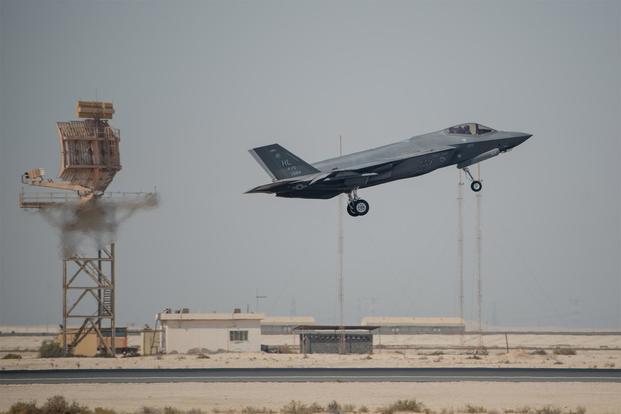As part of the U.S. Air Force's effort to improve how it prepares to deploy at a moment's notice, the service earlier this month tested how swiftly it could move its premier stealth fighter to a forward operating location in the Middle East.
During an exercise called "Agile Lightning," held Aug. 4-7, airmen assigned to the 4th Expeditionary Fighter Squadron of the 388th Fighter Wing at Hill Air Force Base, Utah, temporarily deployed to an undisclosed location in the Middle East to train in an austere environment with the F-35 Joint Strike Fighter, according to a service news release.
"By executing the adaptive basing concepts we have only practiced at home until now, we increased the readiness, survivability and lethality of the F-35A in a combat theater," said Lt. Col. Joshua Arki, 4th EFS commander.
"The 'Fightin' Fuujins' of the 4th EFS successfully deployed a small detachment of aircraft and personnel to a forward location, supporting combat operations from that location for a given period of time, and then re-deployed back to our primary operating location," Arki said in the release.
Related content:
- Air Force Sees Unique Challenges in Deploying Stealth Fighters
- Air Force's F-35A Deploys to Middle East for First Time
- Air Force Planning Shorter, More Frequent Strategic Bomber Rotations
The 4th EFS and the 380th Expeditionary Maintenance Squadron are both assigned to Al Dhafra Air Base, United Arab Emirates, and temporarily deployed to the 332nd Air Expeditionary Wing, Southwest Asia, according to the release.
The Air Force did not say how many F-35 Lightning IIs deployed to the forward operating base; the contingent was part of the service's first-ever deployment of the F-35A variant to the region. The jets first deployed to Al Dhafra in April.
"We were able to safely bring the jets and people here to continue supporting operations with a hundred percent mission effectiveness," said Capt. "Cheque," a 4th EFS pilot identified only by call sign in the release.
"We were also able to gather lessons learned for untethered operations within the [area of responsibility], so that we can more quickly and more efficiently accomplish adaptive basing in the future," the captain said.
The service has said for years that much of the work needed to prepare bases abroad to accommodate the fifth-generation fighter jets, made by Lockheed Martin, comes down to the different processes for maintaining stealth technology on the aircraft.
The squadrons worked to secure the proper "logistics, munitions, force support, communications [and] air mobility," as well as to maintain secure, open channels with the Combined Air Operations Center at Al Udeid Air Base in Qatar needed to execute the exercise, officials said in the release.
C-17 Globemaster III cargo aircraft and KC-10 Extender refueling tankers and their respective squadrons also supported the exercise, according to photos published with the release.
The exercise was just the start of a larger initiative for U.S. aircraft practicing shorter, coordinated deployments.
The head of Air Force Global Strike Command in the spring said that the service is planning more, shorter strategic bomber rotations to test its agility in deploying its heavy aircraft forces around the world.
"I am focused a lot on a different operational mentality in the command, to think about great power competition," Gen. Timothy Ray told reporters during a Defense Writers Group breakfast in Washington, D.C., in April. "I think that signals a little bit more of the dynamic approach that we're going to take."
-- Oriana Pawlyk can be reached at oriana.pawlyk@military.com. Follow her on Twitter at @Oriana0214.













